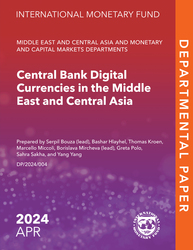
Central Bank Digital Currencies in the Middle East and Central Asia
This paper aims to support Middle East and Central Asia policymakers in examining key questions when considering the adoption of central bank digital currencies while underscoring the importance of country-specific analyses.
READ MORE...
Volume/Issue:
Volume 2024
Issue 004
Publication date: April 2024
ISBN: 9798400263798
$20.00
Add to Cart by clicking price of the language and format you'd like to purchase
Available Languages and Formats
| English |
Topics covered in this book
This title contains information about the following subjects.
Click on a subject if you would like to see other titles with the same subjects.
Banks and Banking , Finance , International - Economics , Public Policy , central , bank , digital , currency , CBDC implementation , CBDC design , CBDC uptake , monetary policy pass-through , market power , CBDC issuance , Central Bank digital currencies , Payment systems , Financial inclusion , Digital financial services , Commercial banks , Middle East and Central Asia , Middle East , North Africa , Central Asia and the Caucasus , Global
Summary
Against the backdrop of a rapidly digitalizing world, there is a growing interest in central bank digital currencies (CBDCs) among central banks, including in the Middle East and Central Asia (ME&CA) region. This paper aims to support ME&CA policymakers in examining key questions when considering the adoption of a CBDC while underscoring the importance of country-specific analyses. This paper does not provide recommendations on CBDC issuance. Instead, it frames the discussion around the following key questions: What is a CBDC? What objectives do policymakers aim to achieve with the issuance of a CBDC? Which inefficiencies in payment systems can CBDCs address? What are the implications of CBDC issuance for financial stability and central bank operational risk? How can CBDC design help achieve policy objectives and mitigate these risks? The paper provides preliminary answers to these questions at the regional level. A survey of IMF teams and public statements from ME&CA policymakers confirm that promoting financial inclusion and making payment systems more efficient (domestic and cross-border) are the top priorities in the region. Payment services through CBDCs, if offered at a lower cost than existing alternatives, could spur competition in the payment market and help increase access to bank accounts, improve financial inclusion, and update legacy technology platforms. CBDCs may also help improve the efficiency of cross-border payment services, especially if designed to address frictions arising from a lack of payment system interoperability, complex processing of compliance checks, long transaction chains, and weak competition. At the same time, CBDCs could negatively impact bank profitability while introducing a substantial operational burden for central banks. However, the exact economic and financial impacts of CBDCs need further study and would depend on estimates of CBDC demand, which are uncertain and country- dependent. CBDC issuance and adoption is a long journey that policymakers should approach with care. Policymakers need to analyze carefully whether a CBDC serves their country’s objectives and whether the expected benefits outweigh the potential costs, in addition to risks for the financial system and operational risks for the central bank.
Copyright © 2010 - 2025
Powered by:
AIDC



